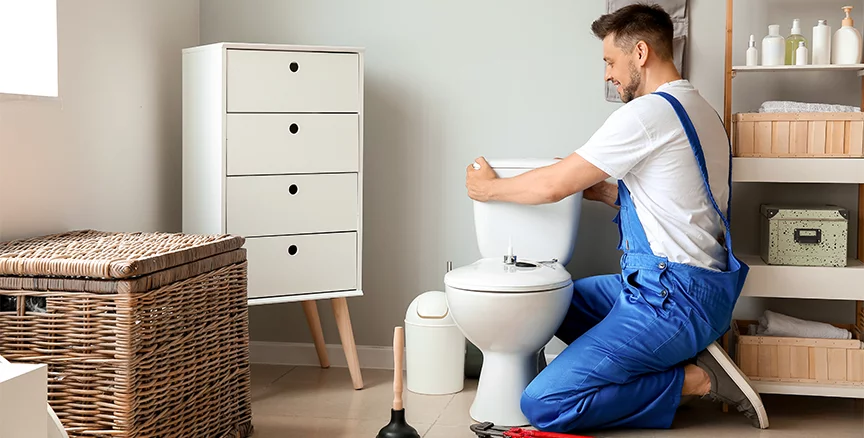Introduction
Are you tired of dealing with a blocked toilet? A clogged toilet can be a tricky and unpleasant problem to resolve on your own. If you’re not careful, you can cause damage to your toilet or pipes. Fortunately, there are a few simple ways to tackle this issue without calling a professional plumber. In this ultimate guide, we will walk you through various methods for fixing a blocked toilet, from basic tools like a toilet plunger or toilet auger to more advanced techniques. We’ll also discuss ways to prevent future clogs and help you maintain a properly functioning toilet moving forward.
The Basics: How to Use a Toilet Plunger
The first and easiest method to unclog a toilet is using a plunger, which is designed to dislodge and remove blockages. To use a plunger, follow these steps:
- First, make sure there is enough water in the bowl to cover the plunger head.
- Place the plunger firmly over the drain hole, making sure to create a tight seal.
- Push down firmly and quickly, then pull back while maintaining the seal.
- Repeat this process several times until the water begins to drain.
- If the plunger does not work, try using a toilet auger (see next section).
Keep in mind that using a plunger may not work for every type of blockage, so if you’re unsuccessful in this method, it’s time to move on to the next step.
Toilet Augers: A Step-by-Step Guide
A toilet auger, also known as a closet auger, is a specialized tool designed specifically for clearing blockages in toilets. The auger has a flexible cable that can reach deeper into the toilet while protecting the toilet bowl from scratches. Here’s how to use a toilet auger:
1. First, insert the auger’s head into the toilet bowl and position it at the bottom of the drain hole.
2. Hold the auger handle with one hand and turn the crank handle clockwise with the other hand.
3. As you turn the crank, the cable will extend into the drain and break up the blockage.
4. If the cable gets stuck, turn the crank counterclockwise to release it, then continue turning clockwise until you reach the blockage.
5. Once the blockage is cleared, withdraw the auger slowly and carefully.
Using a toilet auger may take more time and effort than a plunger, but it can often resolve stubborn clogs that plungers cannot.
The DIY Toilet Snake: An Alternative Method
If you don’t have a toilet auger and a plunger isn’t working, you can create a makeshift toilet snake using a wire coat hanger. To do this:
1. Unwind the coat hanger and straighten it as much as possible.
2. Create a small hook at one end of the hanger to help catch the blockage.
3. Carefully insert the hooked end of the hanger into the toilet drain hole.
4. Gently push and twist the hanger until you feel it reach the blockage.
5. Try to snag the blockage with the hook and pull it out slowly.
This method can be effective for small blockages, but be cautious not to scratch the toilet bowl or damage the pipes.
Prevention Tips: Keeping Your Toilet Clog-Free To avoid dealing with a blocked toilet in the future, consider these preventive measures:
1. Be mindful of what you flush. Only flush toilet paper and human waste; avoid flushing items such as paper towels, sanitary products, or wipes, even if labeled as flushable.
2. Use only the necessary amount of toilet paper, as excessive amounts can cause clogs.
3. Keep a trash bin nearby for non-flushable items.
4. Regularly clean your toilet bowl to remove buildup that can eventually lead to blockages.
5. Inspect the toilet’s internal components periodically to ensure proper functioning.
Following these steps can help prevent clogs and keep your toilet running smoothly.
When to Call a Professional Plumber
If you’ve tried all of the above methods without success or if your toilet is frequently clogging, it’s time to call a professional plumber. They have the expertise and tools to diagnose and repair more advanced issues, such as:
1. Damaged pipes causing repeated clogs
2. Improper toilet installation
3. Inadequate venting, which can affect the toilet’s ability to flush properly
4. Sewer line problems
In these cases, it’s essential to rely on a professional to avoid further damage to your toilet or plumbing system.
Conclusion:
In conclusion, addressing a blocked toilet can be a simple process if you’re equipped with the right tools and knowledge. A toilet plunger is often the easiest and most accessible method for clearing a clog, but a toilet auger or DIY toilet snake can also be effective for more stubborn blockages. To prevent future clogs, be mindful of what you flush and keep up with regular maintenance. Finally, don’t hesitate to call a professional plumber for assistance if you’re unable to unblock the toilet yourself or if the problem persists. A well-maintained toilet is essential for a comfortable and functional home, so invest in its care to avoid any unpleasant surprises down the line.

